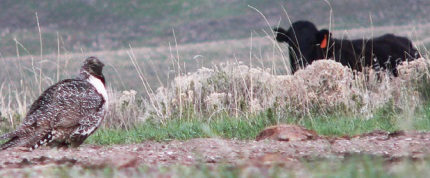Sustainable grazing practices and sagebrush treatments enhanced herbaceous understory for sage grouse in years with average winters, but populations declined following severe winters. Sage grouse populations on the Deseret Land and Livestock (DLL) ranch increased for nearly 15 years when the ranch coupled deferred rest rotation grazing with small sagebrush removal projects. Birds responded positively as evidenced by lek counts that were higher and more stable on DLL than in nearby northeast Utah and western Wyoming. Total sagebrush removal cumulatively modified approximately 15% of DLL’s sage grouse habitat as individual smallscale projects added up through time. Lek counts on DLL declined on the ranch and elsewhere following extreme winter and spring conditions. The cumulative effects of sagebrush removal may have contributed to declines on DLL due to less sagebrush food and cover for birds during severe weather.
Image Source: Sage Grouse Initiative

